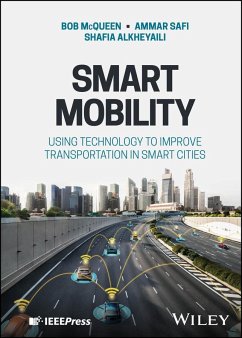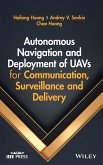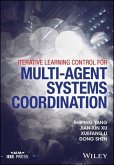Bob McQueen, Ammar Safi, Shafia Alkheyaili
Smart Mobility
Using Technology to Improve Transportation in Smart Cities
Bob McQueen, Ammar Safi, Shafia Alkheyaili
Smart Mobility
Using Technology to Improve Transportation in Smart Cities
- Gebundenes Buch
- Merkliste
- Auf die Merkliste
- Bewerten Bewerten
- Teilen
- Produkt teilen
- Produkterinnerung
- Produkterinnerung
Comprehensive learning resource providing a framework for successful application of advanced transportation technologies in urban areas
Smart Mobility: Using Technology to Improve Transportation in Smart Cities addresses the nature and characteristics of smart cities and provides a focus on smart mobility within urban areas and the opportunities and challenges associated with the application of advanced transportation technologies. The three highly qualified authors include an emphasis on decarbonization possibilities and the potential for smart mobility to reduce emissions and fuel…mehr
Andere Kunden interessierten sich auch für
![Real-Time Ground-Based Flight Data and Cockpit Voice Recorder Real-Time Ground-Based Flight Data and Cockpit Voice Recorder]() Mustafa M. MatalgahReal-Time Ground-Based Flight Data and Cockpit Voice Recorder142,99 €
Mustafa M. MatalgahReal-Time Ground-Based Flight Data and Cockpit Voice Recorder142,99 €![Autonomous Navigation and Deployment of Uavs for Communication, Surveillance and Delivery Autonomous Navigation and Deployment of Uavs for Communication, Surveillance and Delivery]() Hailong HuangAutonomous Navigation and Deployment of Uavs for Communication, Surveillance and Delivery142,99 €
Hailong HuangAutonomous Navigation and Deployment of Uavs for Communication, Surveillance and Delivery142,99 €![Federated Learning for Future Intelligent Wireless Networks Federated Learning for Future Intelligent Wireless Networks]() Federated Learning for Future Intelligent Wireless Networks152,99 €
Federated Learning for Future Intelligent Wireless Networks152,99 €![An Introduction to Audio Content Analysis An Introduction to Audio Content Analysis]() Alexander LerchAn Introduction to Audio Content Analysis142,99 €
Alexander LerchAn Introduction to Audio Content Analysis142,99 €![Iterative Learning Control for Multi-Agent Systems Coordination Iterative Learning Control for Multi-Agent Systems Coordination]() Shiping YangIterative Learning Control for Multi-Agent Systems Coordination152,99 €
Shiping YangIterative Learning Control for Multi-Agent Systems Coordination152,99 €![Parallel Population and Parallel Human Parallel Population and Parallel Human]() Peijun YeParallel Population and Parallel Human142,99 €
Peijun YeParallel Population and Parallel Human142,99 €![Intelligent Manufacturing Management Systems Intelligent Manufacturing Management Systems]() Intelligent Manufacturing Management Systems244,99 €
Intelligent Manufacturing Management Systems244,99 €-
-
-
Comprehensive learning resource providing a framework for successful application of advanced transportation technologies in urban areas
Smart Mobility: Using Technology to Improve Transportation in Smart Cities addresses the nature and characteristics of smart cities and provides a focus on smart mobility within urban areas and the opportunities and challenges associated with the application of advanced transportation technologies. The three highly qualified authors include an emphasis on decarbonization possibilities and the potential for smart mobility to reduce emissions and fuel consumption while optimizing modal use, along with risk identification and management using a structured approach.
A focus is also placed on the need for end-to-end travel support from original origin to ultimate destination, reflecting consumer needs for comprehensive decision support and travel support services. Overall, Smart Mobility: Using Technology to Improve Transportation in Smart Cities provides a framework, planning, and KPIs for smart mobility success and explains how effective performance management can be enabled.
Additional topics covered in the modern and thought-provoking work include:
_ Policies and strategies associated with smart mobility, including a description of the organizational arrangements required to support smart mobility technologies
_ The definition of appropriate institutional, funding, and commercial arrangements to assist interested practitioners to solve what is often their biggest challenge
_ Smart mobility operational management, explaining the likely impact of smart mobility on transportation operations
_ How to attain balance between transportation objectives and the avoidance of undesirable side effects such as congestion
For public and private sector professionals in the smart mobility community, Smart Mobility: Using Technology to Improve Transportation in Smart Cities is an essential and easy-to-understand learning resource that will help readers comprehend the state-of-the-art progress in the field and be prepared for future advancements in this important and rapidly-developing industry.
Smart Mobility: Using Technology to Improve Transportation in Smart Cities addresses the nature and characteristics of smart cities and provides a focus on smart mobility within urban areas and the opportunities and challenges associated with the application of advanced transportation technologies. The three highly qualified authors include an emphasis on decarbonization possibilities and the potential for smart mobility to reduce emissions and fuel consumption while optimizing modal use, along with risk identification and management using a structured approach.
A focus is also placed on the need for end-to-end travel support from original origin to ultimate destination, reflecting consumer needs for comprehensive decision support and travel support services. Overall, Smart Mobility: Using Technology to Improve Transportation in Smart Cities provides a framework, planning, and KPIs for smart mobility success and explains how effective performance management can be enabled.
Additional topics covered in the modern and thought-provoking work include:
_ Policies and strategies associated with smart mobility, including a description of the organizational arrangements required to support smart mobility technologies
_ The definition of appropriate institutional, funding, and commercial arrangements to assist interested practitioners to solve what is often their biggest challenge
_ Smart mobility operational management, explaining the likely impact of smart mobility on transportation operations
_ How to attain balance between transportation objectives and the avoidance of undesirable side effects such as congestion
For public and private sector professionals in the smart mobility community, Smart Mobility: Using Technology to Improve Transportation in Smart Cities is an essential and easy-to-understand learning resource that will help readers comprehend the state-of-the-art progress in the field and be prepared for future advancements in this important and rapidly-developing industry.
Produktdetails
- Produktdetails
- Verlag: Wiley & Sons / Wiley-IEEE Press
- Artikelnr. des Verlages: 1W119847130
- 1. Auflage
- Seitenzahl: 544
- Erscheinungstermin: 13. August 2024
- Englisch
- Abmessung: 254mm x 178mm x 30mm
- Gewicht: 666g
- ISBN-13: 9781119847137
- ISBN-10: 1119847133
- Artikelnr.: 64047310
- Herstellerkennzeichnung
- Libri GmbH
- Europaallee 1
- 36244 Bad Hersfeld
- gpsr@libri.de
- Verlag: Wiley & Sons / Wiley-IEEE Press
- Artikelnr. des Verlages: 1W119847130
- 1. Auflage
- Seitenzahl: 544
- Erscheinungstermin: 13. August 2024
- Englisch
- Abmessung: 254mm x 178mm x 30mm
- Gewicht: 666g
- ISBN-13: 9781119847137
- ISBN-10: 1119847133
- Artikelnr.: 64047310
- Herstellerkennzeichnung
- Libri GmbH
- Europaallee 1
- 36244 Bad Hersfeld
- gpsr@libri.de
Bob McQueen, Bob McQueen and Associates, USA/France, has a broad range of experience in the application of advanced technologies to transportation, gained in assignments over the past 30 years. Ammar Safi, Ministry of Energy and Infrastructure, Dubai, UAE, has 10 years of experience in Telecommunication, Electrical, Mobility, Road Safety, and Infrastructure Engineering. Shafia Alkheyaili, Ministry of Energy and Infrastructure, Dubai, UAE, has eight years of experience in Civil, Mobility, Road Safety, and Infrastructure Engineering.
About the Authors xxi
Preface xxiii
Acknowledgments by Bob McQueen xxv
Acknowledgments by Ammar Safi xxvii
Acknowledgments by Shafia Alkheyaili xxix
1 Introduction 1
1.1 Informational Objectives 1
1.2 Introduction 1
1.3 What Is Smart Mobility? 1
1.4 The Smart Mobility Revolution 4
1.5 Smart Mobility Versus Smart Cities 5
1.6 Informational Objectives of This Chapter 5
1.7 Background 5
1.8 Why This Subject and Why Now? 6
1.9 Intended Readership for the Book 6
1.10 Book Overview 9
2 Smart Cities Overview 15
2.1 Learning Objectives 15
2.2 Introduction 15
2.3 Smart City Services 16
2.4 Affordable Housing 16
2.5 Air Quality 18
2.6 Buildings 20
2.7 Citizen and Visitor Engagement 22
2.8 Construction 24
2.9 Education 25
2.10 Employment 26
2.11 Energy 28
2.12 Finance 30
2.13 Government 31
2.14 Green Spaces 34
2.15 Health 35
2.16 Manufacturing 38
2.17 Mobility 40
2.18 Recycling 42
2.19 Retail and Logistics 46
2.20 Safety 46
2.21 Security 47
2.22 Water 49
2.23 Smart City Service Integration 52
2.24 The Smart Mobility Body of Knowledge 55
2.25 Teamwork and Multiagency Coordination 56
3 Smart Mobility: A Problem Statement 61
3.1 Informational Objectives 61
3.2 What Is a Problem Statement? 61
3.3 Why a Problem Statement Is Important 62
3.4 What Is Smart Mobility? 62
3.5 Why Bother with Smart Mobility? 63
3.6 Modes of Transportation in a City 65
3.7 The Benefits of Smart Mobility 66
3.8 Avoiding any Undesirable Side Effects 69
3.9 Challenges 71
3.10 Developing a Custom Problem Statement 76
3.11 Summary 76
4 The Value and Benefits of Smart Mobility 79
4.1 Informational Objectives 79
4.2 Introduction 79
4.3 Features, Benefits, and Value 80
4.4 The Challenges 82
4.5 The Opportunities 84
4.6 Approach Philosophy 85
4.7 Smart Mobility Benefit-cost Analysis Case Studies 86
4.8 Case Study 3 - Advanced Traffic Management 96
4.9 Developing a Comprehensive Benefits Analysis Framework 100
4.10 Summary 100
5 Smart Mobility Progress Around the World 105
5.1 Informational Objectives 105
5.2 Introduction 105
5.3 A Definition of Smart Mobility 105
5.4 The Importance of Smart Mobility 106
5.5 Review of Key Cities Leading the Way in Smart Mobility 106
5.6 Amsterdam, the Netherlands 106
5.7 Barcelona 113
5.8 Berlin 119
5.9 Dubai 125
5.10 Helsinki 130
5.11 London 139
5.12 New York 144
5.13 Seoul 152
5.14 Singapore 156
5.15 Stockholm 161
5.16 Summary 167
6 Planning for Smart Mobility 175
6.1 Informational Objectives 175
6.2 Introduction 175
6.3 The Objectives of Planning 176
6.4 The Essentials of an Effective Smart Mobility Planning Approach 177
6.5 Smart Mobility Planning Goals 178
6.6 The Value of Planning 179
6.7 Conventional Planning Approach 181
6.8 The "What How" Cycle 183
6.9 Accelerated Insights Approach 183
6.10 Summary 199
7 The Essential Elements of Smart Mobility 201
7.1 Informational Objectives 201
7.2 Introduction 201
7.3 The Essential Elements of Smart Mobility 201
7.4 How Smart Mobility Solutions Can Fit Together 220
7.5 The Importance of Data and Analytics in Smart Mobility Solutions 222
7.6 Smart Mobility Business Models 224
7.7 Summary 228
8 Smart Mobility Technology Applications 231
8.1 Informational Objectives 231
8.2 Introduction 231
8.3 What Is Technology? 233
8.4 Technology Overview 234
8.5 Technology Application Category Overview 235
8.6 The Accelerating Pace of Technology Change 291
8.7 What Is on the Horizon? 292
9 Smart Mobility Opportunities and Challenges 295
9.1 Informational Objectives 295
9.2 Introduction 295
9.3 Smart Mobility Opportunities 295
9.4 Smart Mobility Challenges 306
9.5 Summary 316
10 A Framework for Smart Mobility Success 319
10.1 Informational Objectives 319
10.2 Introduction 319
10.3 The Smart Mobility Success Toolbox 320
10.4 The Application of the Smart Mobility Success Toolbox 339
10.5 Summary 340
11 Smart Mobility Performance Management 343
11.1 Informational Objectives 343
11.2 Introduction 343
11.3 Smart Mobility Performance Management 344
11.4 Smart Mobility Performance Management Approach 345
11.5 A Comprehensive Smart Mobility Performance Management Approach 347
11.6 Managing the Private Sector 353
11.7 Organizing for Performance Management 353
11.8 The Role of Performance Management in Operations Management 354
11.9 Applying Technology to Performance Management 359
11.10 Summary 365
12 Mobility for People 369
12.1 Informational Objectives 369
12.2 Introduction 369
12.3 People Aspects 372
12.4 Traveler Characteristics 376
12.5 Empathetic Design 376
12.6 Customer Psychology 377
12.7 Trip Characteristics 378
12.8 The Mobility Modulor 380
12.9 Why Is It Valuable? 384
12.10 Mobility Modulor Operation and Management 387
12.11 The Functions of the Mobility Modulor 388
12.12 Current Service Delivery Approach 389
12.13 Proposal for a New People-centric Approach 390
12.14 The Possible Effects of Smart Mobility Solutions and Services on
Different Modes Within the Complete Trip 392
12.15 Transitioning to a New People-centric Planning Design and Delivery
Approach 395
12.16 Summary 398
13 Smart Mobility Policy and Strategy 401
13.1 Informational Objectives 401
13.2 Introduction 401
13.3 Smart Mobility Policy 402
13.4 Smart Mobility Strategy 402
13.5 What Should Come First, Policy or Technology Application? 404
13.6 The Influence of Policy and Strategy on Smart Mobility Success 404
13.7 Examples of Smart Mobility Technology Applications 405
13.8 Significant Smart Mobility Policy Areas 410
13.9 The Path from Policy to Operational Management 413
13.10 General Challenges Associated with Smart Mobility Policy and Strategy
415
13.11 Communications Between Policymakers and Technologists 416
13.12 An "Ideal" Policy 416
13.13 Applying Performance Management to Policy 418
13.14 Thoughts on Maximizing the Effectiveness of Smart Mobility Policy 418
13.15 Structured Management of Policy and Strategy 421
13.16 Summary 422
14 Organizing for Smart Mobility Success 425
14.1 Informational Objectives 425
14.2 Introduction 425
14.3 Organizational Goals 426
14.4 Organization Alignment to Business Processes 426
14.5 Case Study - The Ministry of Infrastructure Development, United Arab
Emirates 430
14.6 The Capability Maturity Model 431
14.7 Smart Cities Assessment 432
14.8 Smart Cities Roadmap 441
14.9 Capability Assessment Within the Construction Context 442
14.10 Change Management 445
14.11 The Need for Change Management 446
14.12 Summary 448
15 Smart Mobility Operational Management 449
15.1 Informational Objectives 449
15.2 Introduction 449
15.3 Definition and Essential Elements of Operational Management 451
15.4 The Importance of Operational Management to the Success of Smart
Mobility 457
15.5 Current Transportation Operational Management Processes 458
15.6 Traffic Control and Traffic Flow Optimization 459
15.7 Emergency Management 463
15.8 A Complete Operational Management Approach Incorporating Lessons
Learned from Other Industries 463
15.9 Application Example: Decision Support for Traffic Management 467
15.10 Practical Advice 472
16 Summary 477
16.1 Cities 477
16.2 Lessons 478
16.3 Value 478
16.4 Challenges and Opportunities 479
16.5 Global Progress 479
16.6 Effective Planning 480
16.7 Solutions and Business Models 480
16.8 Technology 481
16.9 Opportunities and Challenges 481
16.10 Accelerating Success 482
16.11 Managing Performance 482
16.12 People Focus 483
16.13 Policies and Strategies 483
16.14 Organizing for Success 483
16.15 Managing Operations 484
16.16 Conclusions 484
Index 487
Preface xxiii
Acknowledgments by Bob McQueen xxv
Acknowledgments by Ammar Safi xxvii
Acknowledgments by Shafia Alkheyaili xxix
1 Introduction 1
1.1 Informational Objectives 1
1.2 Introduction 1
1.3 What Is Smart Mobility? 1
1.4 The Smart Mobility Revolution 4
1.5 Smart Mobility Versus Smart Cities 5
1.6 Informational Objectives of This Chapter 5
1.7 Background 5
1.8 Why This Subject and Why Now? 6
1.9 Intended Readership for the Book 6
1.10 Book Overview 9
2 Smart Cities Overview 15
2.1 Learning Objectives 15
2.2 Introduction 15
2.3 Smart City Services 16
2.4 Affordable Housing 16
2.5 Air Quality 18
2.6 Buildings 20
2.7 Citizen and Visitor Engagement 22
2.8 Construction 24
2.9 Education 25
2.10 Employment 26
2.11 Energy 28
2.12 Finance 30
2.13 Government 31
2.14 Green Spaces 34
2.15 Health 35
2.16 Manufacturing 38
2.17 Mobility 40
2.18 Recycling 42
2.19 Retail and Logistics 46
2.20 Safety 46
2.21 Security 47
2.22 Water 49
2.23 Smart City Service Integration 52
2.24 The Smart Mobility Body of Knowledge 55
2.25 Teamwork and Multiagency Coordination 56
3 Smart Mobility: A Problem Statement 61
3.1 Informational Objectives 61
3.2 What Is a Problem Statement? 61
3.3 Why a Problem Statement Is Important 62
3.4 What Is Smart Mobility? 62
3.5 Why Bother with Smart Mobility? 63
3.6 Modes of Transportation in a City 65
3.7 The Benefits of Smart Mobility 66
3.8 Avoiding any Undesirable Side Effects 69
3.9 Challenges 71
3.10 Developing a Custom Problem Statement 76
3.11 Summary 76
4 The Value and Benefits of Smart Mobility 79
4.1 Informational Objectives 79
4.2 Introduction 79
4.3 Features, Benefits, and Value 80
4.4 The Challenges 82
4.5 The Opportunities 84
4.6 Approach Philosophy 85
4.7 Smart Mobility Benefit-cost Analysis Case Studies 86
4.8 Case Study 3 - Advanced Traffic Management 96
4.9 Developing a Comprehensive Benefits Analysis Framework 100
4.10 Summary 100
5 Smart Mobility Progress Around the World 105
5.1 Informational Objectives 105
5.2 Introduction 105
5.3 A Definition of Smart Mobility 105
5.4 The Importance of Smart Mobility 106
5.5 Review of Key Cities Leading the Way in Smart Mobility 106
5.6 Amsterdam, the Netherlands 106
5.7 Barcelona 113
5.8 Berlin 119
5.9 Dubai 125
5.10 Helsinki 130
5.11 London 139
5.12 New York 144
5.13 Seoul 152
5.14 Singapore 156
5.15 Stockholm 161
5.16 Summary 167
6 Planning for Smart Mobility 175
6.1 Informational Objectives 175
6.2 Introduction 175
6.3 The Objectives of Planning 176
6.4 The Essentials of an Effective Smart Mobility Planning Approach 177
6.5 Smart Mobility Planning Goals 178
6.6 The Value of Planning 179
6.7 Conventional Planning Approach 181
6.8 The "What How" Cycle 183
6.9 Accelerated Insights Approach 183
6.10 Summary 199
7 The Essential Elements of Smart Mobility 201
7.1 Informational Objectives 201
7.2 Introduction 201
7.3 The Essential Elements of Smart Mobility 201
7.4 How Smart Mobility Solutions Can Fit Together 220
7.5 The Importance of Data and Analytics in Smart Mobility Solutions 222
7.6 Smart Mobility Business Models 224
7.7 Summary 228
8 Smart Mobility Technology Applications 231
8.1 Informational Objectives 231
8.2 Introduction 231
8.3 What Is Technology? 233
8.4 Technology Overview 234
8.5 Technology Application Category Overview 235
8.6 The Accelerating Pace of Technology Change 291
8.7 What Is on the Horizon? 292
9 Smart Mobility Opportunities and Challenges 295
9.1 Informational Objectives 295
9.2 Introduction 295
9.3 Smart Mobility Opportunities 295
9.4 Smart Mobility Challenges 306
9.5 Summary 316
10 A Framework for Smart Mobility Success 319
10.1 Informational Objectives 319
10.2 Introduction 319
10.3 The Smart Mobility Success Toolbox 320
10.4 The Application of the Smart Mobility Success Toolbox 339
10.5 Summary 340
11 Smart Mobility Performance Management 343
11.1 Informational Objectives 343
11.2 Introduction 343
11.3 Smart Mobility Performance Management 344
11.4 Smart Mobility Performance Management Approach 345
11.5 A Comprehensive Smart Mobility Performance Management Approach 347
11.6 Managing the Private Sector 353
11.7 Organizing for Performance Management 353
11.8 The Role of Performance Management in Operations Management 354
11.9 Applying Technology to Performance Management 359
11.10 Summary 365
12 Mobility for People 369
12.1 Informational Objectives 369
12.2 Introduction 369
12.3 People Aspects 372
12.4 Traveler Characteristics 376
12.5 Empathetic Design 376
12.6 Customer Psychology 377
12.7 Trip Characteristics 378
12.8 The Mobility Modulor 380
12.9 Why Is It Valuable? 384
12.10 Mobility Modulor Operation and Management 387
12.11 The Functions of the Mobility Modulor 388
12.12 Current Service Delivery Approach 389
12.13 Proposal for a New People-centric Approach 390
12.14 The Possible Effects of Smart Mobility Solutions and Services on
Different Modes Within the Complete Trip 392
12.15 Transitioning to a New People-centric Planning Design and Delivery
Approach 395
12.16 Summary 398
13 Smart Mobility Policy and Strategy 401
13.1 Informational Objectives 401
13.2 Introduction 401
13.3 Smart Mobility Policy 402
13.4 Smart Mobility Strategy 402
13.5 What Should Come First, Policy or Technology Application? 404
13.6 The Influence of Policy and Strategy on Smart Mobility Success 404
13.7 Examples of Smart Mobility Technology Applications 405
13.8 Significant Smart Mobility Policy Areas 410
13.9 The Path from Policy to Operational Management 413
13.10 General Challenges Associated with Smart Mobility Policy and Strategy
415
13.11 Communications Between Policymakers and Technologists 416
13.12 An "Ideal" Policy 416
13.13 Applying Performance Management to Policy 418
13.14 Thoughts on Maximizing the Effectiveness of Smart Mobility Policy 418
13.15 Structured Management of Policy and Strategy 421
13.16 Summary 422
14 Organizing for Smart Mobility Success 425
14.1 Informational Objectives 425
14.2 Introduction 425
14.3 Organizational Goals 426
14.4 Organization Alignment to Business Processes 426
14.5 Case Study - The Ministry of Infrastructure Development, United Arab
Emirates 430
14.6 The Capability Maturity Model 431
14.7 Smart Cities Assessment 432
14.8 Smart Cities Roadmap 441
14.9 Capability Assessment Within the Construction Context 442
14.10 Change Management 445
14.11 The Need for Change Management 446
14.12 Summary 448
15 Smart Mobility Operational Management 449
15.1 Informational Objectives 449
15.2 Introduction 449
15.3 Definition and Essential Elements of Operational Management 451
15.4 The Importance of Operational Management to the Success of Smart
Mobility 457
15.5 Current Transportation Operational Management Processes 458
15.6 Traffic Control and Traffic Flow Optimization 459
15.7 Emergency Management 463
15.8 A Complete Operational Management Approach Incorporating Lessons
Learned from Other Industries 463
15.9 Application Example: Decision Support for Traffic Management 467
15.10 Practical Advice 472
16 Summary 477
16.1 Cities 477
16.2 Lessons 478
16.3 Value 478
16.4 Challenges and Opportunities 479
16.5 Global Progress 479
16.6 Effective Planning 480
16.7 Solutions and Business Models 480
16.8 Technology 481
16.9 Opportunities and Challenges 481
16.10 Accelerating Success 482
16.11 Managing Performance 482
16.12 People Focus 483
16.13 Policies and Strategies 483
16.14 Organizing for Success 483
16.15 Managing Operations 484
16.16 Conclusions 484
Index 487
About the Authors xxi
Preface xxiii
Acknowledgments by Bob McQueen xxv
Acknowledgments by Ammar Safi xxvii
Acknowledgments by Shafia Alkheyaili xxix
1 Introduction 1
1.1 Informational Objectives 1
1.2 Introduction 1
1.3 What Is Smart Mobility? 1
1.4 The Smart Mobility Revolution 4
1.5 Smart Mobility Versus Smart Cities 5
1.6 Informational Objectives of This Chapter 5
1.7 Background 5
1.8 Why This Subject and Why Now? 6
1.9 Intended Readership for the Book 6
1.10 Book Overview 9
2 Smart Cities Overview 15
2.1 Learning Objectives 15
2.2 Introduction 15
2.3 Smart City Services 16
2.4 Affordable Housing 16
2.5 Air Quality 18
2.6 Buildings 20
2.7 Citizen and Visitor Engagement 22
2.8 Construction 24
2.9 Education 25
2.10 Employment 26
2.11 Energy 28
2.12 Finance 30
2.13 Government 31
2.14 Green Spaces 34
2.15 Health 35
2.16 Manufacturing 38
2.17 Mobility 40
2.18 Recycling 42
2.19 Retail and Logistics 46
2.20 Safety 46
2.21 Security 47
2.22 Water 49
2.23 Smart City Service Integration 52
2.24 The Smart Mobility Body of Knowledge 55
2.25 Teamwork and Multiagency Coordination 56
3 Smart Mobility: A Problem Statement 61
3.1 Informational Objectives 61
3.2 What Is a Problem Statement? 61
3.3 Why a Problem Statement Is Important 62
3.4 What Is Smart Mobility? 62
3.5 Why Bother with Smart Mobility? 63
3.6 Modes of Transportation in a City 65
3.7 The Benefits of Smart Mobility 66
3.8 Avoiding any Undesirable Side Effects 69
3.9 Challenges 71
3.10 Developing a Custom Problem Statement 76
3.11 Summary 76
4 The Value and Benefits of Smart Mobility 79
4.1 Informational Objectives 79
4.2 Introduction 79
4.3 Features, Benefits, and Value 80
4.4 The Challenges 82
4.5 The Opportunities 84
4.6 Approach Philosophy 85
4.7 Smart Mobility Benefit-cost Analysis Case Studies 86
4.8 Case Study 3 - Advanced Traffic Management 96
4.9 Developing a Comprehensive Benefits Analysis Framework 100
4.10 Summary 100
5 Smart Mobility Progress Around the World 105
5.1 Informational Objectives 105
5.2 Introduction 105
5.3 A Definition of Smart Mobility 105
5.4 The Importance of Smart Mobility 106
5.5 Review of Key Cities Leading the Way in Smart Mobility 106
5.6 Amsterdam, the Netherlands 106
5.7 Barcelona 113
5.8 Berlin 119
5.9 Dubai 125
5.10 Helsinki 130
5.11 London 139
5.12 New York 144
5.13 Seoul 152
5.14 Singapore 156
5.15 Stockholm 161
5.16 Summary 167
6 Planning for Smart Mobility 175
6.1 Informational Objectives 175
6.2 Introduction 175
6.3 The Objectives of Planning 176
6.4 The Essentials of an Effective Smart Mobility Planning Approach 177
6.5 Smart Mobility Planning Goals 178
6.6 The Value of Planning 179
6.7 Conventional Planning Approach 181
6.8 The "What How" Cycle 183
6.9 Accelerated Insights Approach 183
6.10 Summary 199
7 The Essential Elements of Smart Mobility 201
7.1 Informational Objectives 201
7.2 Introduction 201
7.3 The Essential Elements of Smart Mobility 201
7.4 How Smart Mobility Solutions Can Fit Together 220
7.5 The Importance of Data and Analytics in Smart Mobility Solutions 222
7.6 Smart Mobility Business Models 224
7.7 Summary 228
8 Smart Mobility Technology Applications 231
8.1 Informational Objectives 231
8.2 Introduction 231
8.3 What Is Technology? 233
8.4 Technology Overview 234
8.5 Technology Application Category Overview 235
8.6 The Accelerating Pace of Technology Change 291
8.7 What Is on the Horizon? 292
9 Smart Mobility Opportunities and Challenges 295
9.1 Informational Objectives 295
9.2 Introduction 295
9.3 Smart Mobility Opportunities 295
9.4 Smart Mobility Challenges 306
9.5 Summary 316
10 A Framework for Smart Mobility Success 319
10.1 Informational Objectives 319
10.2 Introduction 319
10.3 The Smart Mobility Success Toolbox 320
10.4 The Application of the Smart Mobility Success Toolbox 339
10.5 Summary 340
11 Smart Mobility Performance Management 343
11.1 Informational Objectives 343
11.2 Introduction 343
11.3 Smart Mobility Performance Management 344
11.4 Smart Mobility Performance Management Approach 345
11.5 A Comprehensive Smart Mobility Performance Management Approach 347
11.6 Managing the Private Sector 353
11.7 Organizing for Performance Management 353
11.8 The Role of Performance Management in Operations Management 354
11.9 Applying Technology to Performance Management 359
11.10 Summary 365
12 Mobility for People 369
12.1 Informational Objectives 369
12.2 Introduction 369
12.3 People Aspects 372
12.4 Traveler Characteristics 376
12.5 Empathetic Design 376
12.6 Customer Psychology 377
12.7 Trip Characteristics 378
12.8 The Mobility Modulor 380
12.9 Why Is It Valuable? 384
12.10 Mobility Modulor Operation and Management 387
12.11 The Functions of the Mobility Modulor 388
12.12 Current Service Delivery Approach 389
12.13 Proposal for a New People-centric Approach 390
12.14 The Possible Effects of Smart Mobility Solutions and Services on
Different Modes Within the Complete Trip 392
12.15 Transitioning to a New People-centric Planning Design and Delivery
Approach 395
12.16 Summary 398
13 Smart Mobility Policy and Strategy 401
13.1 Informational Objectives 401
13.2 Introduction 401
13.3 Smart Mobility Policy 402
13.4 Smart Mobility Strategy 402
13.5 What Should Come First, Policy or Technology Application? 404
13.6 The Influence of Policy and Strategy on Smart Mobility Success 404
13.7 Examples of Smart Mobility Technology Applications 405
13.8 Significant Smart Mobility Policy Areas 410
13.9 The Path from Policy to Operational Management 413
13.10 General Challenges Associated with Smart Mobility Policy and Strategy
415
13.11 Communications Between Policymakers and Technologists 416
13.12 An "Ideal" Policy 416
13.13 Applying Performance Management to Policy 418
13.14 Thoughts on Maximizing the Effectiveness of Smart Mobility Policy 418
13.15 Structured Management of Policy and Strategy 421
13.16 Summary 422
14 Organizing for Smart Mobility Success 425
14.1 Informational Objectives 425
14.2 Introduction 425
14.3 Organizational Goals 426
14.4 Organization Alignment to Business Processes 426
14.5 Case Study - The Ministry of Infrastructure Development, United Arab
Emirates 430
14.6 The Capability Maturity Model 431
14.7 Smart Cities Assessment 432
14.8 Smart Cities Roadmap 441
14.9 Capability Assessment Within the Construction Context 442
14.10 Change Management 445
14.11 The Need for Change Management 446
14.12 Summary 448
15 Smart Mobility Operational Management 449
15.1 Informational Objectives 449
15.2 Introduction 449
15.3 Definition and Essential Elements of Operational Management 451
15.4 The Importance of Operational Management to the Success of Smart
Mobility 457
15.5 Current Transportation Operational Management Processes 458
15.6 Traffic Control and Traffic Flow Optimization 459
15.7 Emergency Management 463
15.8 A Complete Operational Management Approach Incorporating Lessons
Learned from Other Industries 463
15.9 Application Example: Decision Support for Traffic Management 467
15.10 Practical Advice 472
16 Summary 477
16.1 Cities 477
16.2 Lessons 478
16.3 Value 478
16.4 Challenges and Opportunities 479
16.5 Global Progress 479
16.6 Effective Planning 480
16.7 Solutions and Business Models 480
16.8 Technology 481
16.9 Opportunities and Challenges 481
16.10 Accelerating Success 482
16.11 Managing Performance 482
16.12 People Focus 483
16.13 Policies and Strategies 483
16.14 Organizing for Success 483
16.15 Managing Operations 484
16.16 Conclusions 484
Index 487
Preface xxiii
Acknowledgments by Bob McQueen xxv
Acknowledgments by Ammar Safi xxvii
Acknowledgments by Shafia Alkheyaili xxix
1 Introduction 1
1.1 Informational Objectives 1
1.2 Introduction 1
1.3 What Is Smart Mobility? 1
1.4 The Smart Mobility Revolution 4
1.5 Smart Mobility Versus Smart Cities 5
1.6 Informational Objectives of This Chapter 5
1.7 Background 5
1.8 Why This Subject and Why Now? 6
1.9 Intended Readership for the Book 6
1.10 Book Overview 9
2 Smart Cities Overview 15
2.1 Learning Objectives 15
2.2 Introduction 15
2.3 Smart City Services 16
2.4 Affordable Housing 16
2.5 Air Quality 18
2.6 Buildings 20
2.7 Citizen and Visitor Engagement 22
2.8 Construction 24
2.9 Education 25
2.10 Employment 26
2.11 Energy 28
2.12 Finance 30
2.13 Government 31
2.14 Green Spaces 34
2.15 Health 35
2.16 Manufacturing 38
2.17 Mobility 40
2.18 Recycling 42
2.19 Retail and Logistics 46
2.20 Safety 46
2.21 Security 47
2.22 Water 49
2.23 Smart City Service Integration 52
2.24 The Smart Mobility Body of Knowledge 55
2.25 Teamwork and Multiagency Coordination 56
3 Smart Mobility: A Problem Statement 61
3.1 Informational Objectives 61
3.2 What Is a Problem Statement? 61
3.3 Why a Problem Statement Is Important 62
3.4 What Is Smart Mobility? 62
3.5 Why Bother with Smart Mobility? 63
3.6 Modes of Transportation in a City 65
3.7 The Benefits of Smart Mobility 66
3.8 Avoiding any Undesirable Side Effects 69
3.9 Challenges 71
3.10 Developing a Custom Problem Statement 76
3.11 Summary 76
4 The Value and Benefits of Smart Mobility 79
4.1 Informational Objectives 79
4.2 Introduction 79
4.3 Features, Benefits, and Value 80
4.4 The Challenges 82
4.5 The Opportunities 84
4.6 Approach Philosophy 85
4.7 Smart Mobility Benefit-cost Analysis Case Studies 86
4.8 Case Study 3 - Advanced Traffic Management 96
4.9 Developing a Comprehensive Benefits Analysis Framework 100
4.10 Summary 100
5 Smart Mobility Progress Around the World 105
5.1 Informational Objectives 105
5.2 Introduction 105
5.3 A Definition of Smart Mobility 105
5.4 The Importance of Smart Mobility 106
5.5 Review of Key Cities Leading the Way in Smart Mobility 106
5.6 Amsterdam, the Netherlands 106
5.7 Barcelona 113
5.8 Berlin 119
5.9 Dubai 125
5.10 Helsinki 130
5.11 London 139
5.12 New York 144
5.13 Seoul 152
5.14 Singapore 156
5.15 Stockholm 161
5.16 Summary 167
6 Planning for Smart Mobility 175
6.1 Informational Objectives 175
6.2 Introduction 175
6.3 The Objectives of Planning 176
6.4 The Essentials of an Effective Smart Mobility Planning Approach 177
6.5 Smart Mobility Planning Goals 178
6.6 The Value of Planning 179
6.7 Conventional Planning Approach 181
6.8 The "What How" Cycle 183
6.9 Accelerated Insights Approach 183
6.10 Summary 199
7 The Essential Elements of Smart Mobility 201
7.1 Informational Objectives 201
7.2 Introduction 201
7.3 The Essential Elements of Smart Mobility 201
7.4 How Smart Mobility Solutions Can Fit Together 220
7.5 The Importance of Data and Analytics in Smart Mobility Solutions 222
7.6 Smart Mobility Business Models 224
7.7 Summary 228
8 Smart Mobility Technology Applications 231
8.1 Informational Objectives 231
8.2 Introduction 231
8.3 What Is Technology? 233
8.4 Technology Overview 234
8.5 Technology Application Category Overview 235
8.6 The Accelerating Pace of Technology Change 291
8.7 What Is on the Horizon? 292
9 Smart Mobility Opportunities and Challenges 295
9.1 Informational Objectives 295
9.2 Introduction 295
9.3 Smart Mobility Opportunities 295
9.4 Smart Mobility Challenges 306
9.5 Summary 316
10 A Framework for Smart Mobility Success 319
10.1 Informational Objectives 319
10.2 Introduction 319
10.3 The Smart Mobility Success Toolbox 320
10.4 The Application of the Smart Mobility Success Toolbox 339
10.5 Summary 340
11 Smart Mobility Performance Management 343
11.1 Informational Objectives 343
11.2 Introduction 343
11.3 Smart Mobility Performance Management 344
11.4 Smart Mobility Performance Management Approach 345
11.5 A Comprehensive Smart Mobility Performance Management Approach 347
11.6 Managing the Private Sector 353
11.7 Organizing for Performance Management 353
11.8 The Role of Performance Management in Operations Management 354
11.9 Applying Technology to Performance Management 359
11.10 Summary 365
12 Mobility for People 369
12.1 Informational Objectives 369
12.2 Introduction 369
12.3 People Aspects 372
12.4 Traveler Characteristics 376
12.5 Empathetic Design 376
12.6 Customer Psychology 377
12.7 Trip Characteristics 378
12.8 The Mobility Modulor 380
12.9 Why Is It Valuable? 384
12.10 Mobility Modulor Operation and Management 387
12.11 The Functions of the Mobility Modulor 388
12.12 Current Service Delivery Approach 389
12.13 Proposal for a New People-centric Approach 390
12.14 The Possible Effects of Smart Mobility Solutions and Services on
Different Modes Within the Complete Trip 392
12.15 Transitioning to a New People-centric Planning Design and Delivery
Approach 395
12.16 Summary 398
13 Smart Mobility Policy and Strategy 401
13.1 Informational Objectives 401
13.2 Introduction 401
13.3 Smart Mobility Policy 402
13.4 Smart Mobility Strategy 402
13.5 What Should Come First, Policy or Technology Application? 404
13.6 The Influence of Policy and Strategy on Smart Mobility Success 404
13.7 Examples of Smart Mobility Technology Applications 405
13.8 Significant Smart Mobility Policy Areas 410
13.9 The Path from Policy to Operational Management 413
13.10 General Challenges Associated with Smart Mobility Policy and Strategy
415
13.11 Communications Between Policymakers and Technologists 416
13.12 An "Ideal" Policy 416
13.13 Applying Performance Management to Policy 418
13.14 Thoughts on Maximizing the Effectiveness of Smart Mobility Policy 418
13.15 Structured Management of Policy and Strategy 421
13.16 Summary 422
14 Organizing for Smart Mobility Success 425
14.1 Informational Objectives 425
14.2 Introduction 425
14.3 Organizational Goals 426
14.4 Organization Alignment to Business Processes 426
14.5 Case Study - The Ministry of Infrastructure Development, United Arab
Emirates 430
14.6 The Capability Maturity Model 431
14.7 Smart Cities Assessment 432
14.8 Smart Cities Roadmap 441
14.9 Capability Assessment Within the Construction Context 442
14.10 Change Management 445
14.11 The Need for Change Management 446
14.12 Summary 448
15 Smart Mobility Operational Management 449
15.1 Informational Objectives 449
15.2 Introduction 449
15.3 Definition and Essential Elements of Operational Management 451
15.4 The Importance of Operational Management to the Success of Smart
Mobility 457
15.5 Current Transportation Operational Management Processes 458
15.6 Traffic Control and Traffic Flow Optimization 459
15.7 Emergency Management 463
15.8 A Complete Operational Management Approach Incorporating Lessons
Learned from Other Industries 463
15.9 Application Example: Decision Support for Traffic Management 467
15.10 Practical Advice 472
16 Summary 477
16.1 Cities 477
16.2 Lessons 478
16.3 Value 478
16.4 Challenges and Opportunities 479
16.5 Global Progress 479
16.6 Effective Planning 480
16.7 Solutions and Business Models 480
16.8 Technology 481
16.9 Opportunities and Challenges 481
16.10 Accelerating Success 482
16.11 Managing Performance 482
16.12 People Focus 483
16.13 Policies and Strategies 483
16.14 Organizing for Success 483
16.15 Managing Operations 484
16.16 Conclusions 484
Index 487








